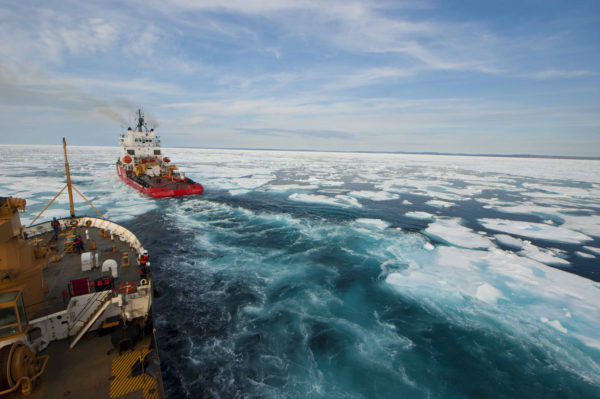Canada’s new transport minister must captain a bold environmental agenda for shipping

Canada has a high responsibility because of our geography on three oceans and the environmental burden of shipping that will keep increasing as more vessels transit our waters. Our new transport minister has an opportunity to implement bold ambitious policies that not only protect Canada’s biodiversity and address the climate crisis, but send a clear message to Canadians, and the world, that our leaders are serious about righting this ship.
Prime Minister Justin Trudeau unveiled his new cabinet on Nov. 20. Transport Minister Marc Garneau remains at that helm but his new mandate must address the dramatic implications of shipping on climate, wildlife and pollution, especially as traffic ramps up in the melting Arctic.
Every time a cruise ship or merchant vessel sets sail, the climate crisis threatening our planet worsens—annual CO2 emissions from the global shipping industry are equal to that of Germany, the world’s sixth largest emitter. Research also shows dirty air from ship smokestacks contributes to hundreds of thousands of premature deaths from lung cancer and cardiovascular disease, and the release of black carbon, or soot, is worsening Arctic sea-ice melt which threatens ice-dependent species.
But shipping pollution isn’t limited to airborne emissions. Grey water—wastewater from cooking, cleaning, sinks, and showers on ships—can also have a devastating impact on aquatic wildlife. This discharge can contain oil and grease that suffocates fish by coating their gills; it also contains particulates that choke other marine life like lobsters and crabs.
Recent World Wildlife Fund Canada studies have found that 1.54 billion litres of grey water were likely dumped off the British Columbia coast in 2017, the vast majority coming from cruise ships, and that grey water discharges into the Canadian Arctic are expected to double by 2035.
Merchant vessels and cruise ships themselves also pose a physical hazard to marine life. Already down to fewer than 500, the North Atlantic Right Whale population has been further reduced by deaths caused by ship strikes in the Gulf of St. Lawrence.
There are some solutions that have already been employed to reduce harm to oceans and marine life, which a new Transport Minister could expand or launch federally.
Transport Canada has put speed limits on ships transiting the Gulf of St. Lawrence to reduce danger to North Atlantic Right Whales, and fined operators for exceeding them. The Port of Vancouver has reduced harbour fees for quieter ships, improving the ability of Southern Resident Killer Whales to feed. Alaska has adopted stringent controls on pollution discharges, like sewage and grey water, by monitoring and prohibiting untreated releases near their coast.
There are even more options on the drawing board, including ships that use solar and wind power and depend less on fossil fuels. The cruise ship Roald Amundsen, for example, recently became the first battery-hybrid powered ship to traverse the Northwest Passage. But there are currently only a handful of alternative propulsion ships and replacing the 50,000 merchant and cruise vessels currently plying the world’s oceans will take decades. These are all positive developments, but they’re currently a proverbial drop in the ocean and time is of the essence. That’s why it’s so important that Transport Canada’s new captain chooses to seize this fleeting moment with a courageous, future-focused mandate that includes:
Deep cuts to emissions: Domestic shipping needs to continue to be included in the carbon pricing regime and be subject to federal regulations that will result in zero CO2 emissions in Canada’s inland waters by 2030.
National speed limits: Reducing the speed of marine vessels lowers chances of harmful, and often fatal, ship strikes on marine mammals, while also reducing greenhouse gas emissions and underwater noise.
Ban heavy fuel oil in the Arctic: Heavy fuel oil (HFO) is a particularly polluting ship fuel. It produces black carbon, or soot, which causes Arctic sea ice to melt by increasing local warming and negatively affects human health. If spilled in cold polar waters, HFO breaks down slowly,persisting for weeks with devastating impacts on marine life and coastal communities. That’s why it’s already been banned in Antarctic waters.
Eliminate ocean dumping: Canada’s coastal communities rely on healthy, productive oceans for economic reasons, personal health, and cultural well-being. Commercial fisheries, eco-tourism andother important coastal industries are put at risk by the discharge of harmful substances from vessels like grey water, scrubber effluent, plastics, sewage, and oily substances.
Incentivize quieter ships: Mandate that local vessel builds are designed to be both energy efficient and quieter, while expanding programs like Vancouver’s policy of noise-based fee reductions.
Think globally: Shipping is global, so solutions must also be global. The International Maritime Organization has called for reducing emissions to 50 per cent of 2008 levels by 2050. That isn’t even close to what’s needed to keep global temperature rise to 1.5 degrees. The new transport minister must work with the IMO and other international organizations to bring the shipping sector down to zero emissions by 2050, as well as pursuing global agreements for ship building and pollution.
Canada has a high responsibility because of our geography on three oceans and the environmental burden of shipping that will keep increasing as more vessels transit our waters. Our new transport minister has an opportunity to implement bold ambitious policies that not only protect Canada’s biodiversity and address the climate crisis, but send a clear message to Canadians, and the world, that our leaders are serious about righting this ship.
Originally published in the Hill Times: https://bit.ly/2QFbAm2

